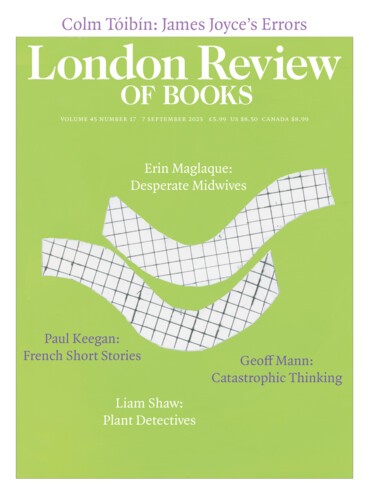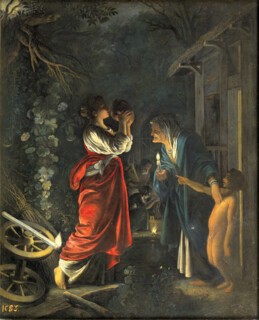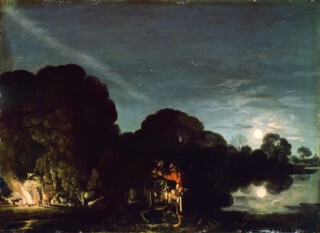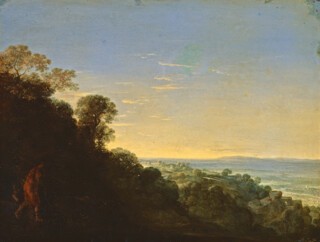For most students of art history today, the most exciting development in Italy – indeed in all of Europe – around 1600 was the revolutionary realism of Caravaggio. He established his reputation in Rome as a painter of still life and made a point of painting directly from nature: from fruit held by a studio lad, from his own facial expressions in a mirror, from a bird’s wing (when an angel was to be depicted), from a woman holding a heavy infant (when the Virgin and Child was the subject). Admiration for his paintings, felt strongly for half a century by artists and collectors, and later, briefly, by French artists in the early 19th century, grew dramatically during the 20th century, and he is now so popular that in one Roman church where his work can be seen a special entrance facility has been put in place.
Before the 20th-century cult of Caravaggio came into being, writers on Western art acknowledged that a major development had occurred in Rome around 1600 on account of Annibale Carracci, an older artist, then at work with his Bolognese associates on the gallery of Palazzo Farnese. Annibale, in addition to reviving the style of Raphael’s Roman frescoes and the earliest style of Michelangelo’s Sistine ceiling, had adopted their practice of drawing from the living model – a practice that was to become fundamental in the teaching of the European academies. The heroic style of Annibale’s painting had a grounding in nature and the male nude model is everywhere on display, especially supporting the narratives of the loves of the gods, and in the statues that form a part of his fictive architecture.
Julian Bell is aware of these conspicuous peaks, but has chosen to explore a foothill or outcrop in the artistic landscape. Adam Elsheimer is far less famous than Caravaggio or Annibale Carracci, but he has not been neglected by art historians. He worked first in his native Frankfurt, then in Venice, is recorded as a painter in Rome in 1600 and died there ten years later, aged 32. His paintings excited great esteem in that last decade, at least among artists, collectors and connoisseurs. A self-portrait, probably made for the Accademia di San Luca, is his only known work on canvas. Otherwise, he painted on copper panels, a type of support that was becoming increasingly available to meet the demand for engravings. Such paintings were especially favoured for a new type of miniature luxury architecture: elaborate cabinets and tabernacle frames (some of which served as domestic altarpieces) made out of ebony or black marble – both also newly available. The paintings were incorporated with inlaid semi-precious stones and rare marbles, and the structures were crowned with statuettes of gilded bronze or silver. Elsheimer created paintings for at least three ensembles of this kind but also made, often perhaps without commission, small copper ‘cabinet pictures’ in the sense still in use today – paintings made to be displayed in a small room, to be looked into, as distinct from those designed to be looked at in a gallery. Visitors to the monographic exhibition of Elsheimer’s work mounted in Frankfurt, Edinburgh and Dulwich in 2006 were supplied with magnifying glasses.
Although Elsheimer provided miniatures for private and privileged delectation, his work enjoyed an enormous influence, partly because of his close association with a great engraver, Hendrick Goudt, but also because his inventions possess a certain monumentality and indeed often grow larger in recollection. The Mocking of Ceres, perhaps his most famous figure composition, features a standing woman quenching her thirst, watched intently by a wrinkled older woman and laughed at by a naked urchin at her side. It is a nocturnal scene, set in a forest lit by the full moon. A fire has been lit near some rural buildings and the foreground figures are illuminated by a torch which the thirsty woman (who is in fact Ceres) has been carrying in her ceaseless search for her daughter. Light is also provided by a taper held by the old woman, who has provided the jug of drink. The darkness contributes to the drama of the episode; the lights sharpen the profile of the old woman, distort the laughing features of the boy, and endow the folds of the drinker’s robes with the shapes of rising flames or of water cascading over rocks. The subject, from Ovid, was an obscure one, hardly ever treated before in art, but to be taken up on a larger scale in a startling painting probably by a northern follower of Caravaggio, sold at Sotheby’s in July 1990, which concentrates only on the three expressive heads.
Some memory of The Mocking of Ceres surely lies behind the great early masterpiece by Rubens of Samson and Delilah, which also features both taper and torch, a heroine wearing a blood-red dress, and an eager old woman in profile (the ‘crone’ of so many misogynistic fairy tales). It must have been painted shortly after Rubens had expressed his sorrow at the news of Elsheimer’s death. This conjecture is reinforced by the fact that we know that Rubens, who had admired Elsheimer’s paintings during his stay in Rome, owned the excellent copy or replica of The Mocking of Ceres that is now in the Prado. There is also, as Bell points out, a connection – indeed a more obvious one – between Elsheimer’s painting (now in Apsley House) of Judith hacking off the head of Holofernes and a lost painting by Rubens of the subject, known from an engraving by Cornelis Galle. Bell here also considers the relationship of Elsheimer’s work to that of Caravaggio and his followers, noting that ‘the huge blood-soaked convulsion’ painted by Artemisia Gentileschi soon after Elsheimer’s death owes more to Elsheimer’s version of this subject than to Caravaggio’s.
Bell is concerned to elucidate the different meanings given to ‘nature’ and ‘the natural’ at the time. By his own testimony, nature was Caravaggio’s guide, but he seems to have had little feeling for what we think of as the natural world: the world outside the studio; the ‘view’, even from a window, of trees and hills and mountains. When a landscape setting was required in The Rest on the Flight into Egypt (now in the Doria Pamphilj Gallery in Rome) he made do with branches brought into his studio. Distant figures can be discerned with some difficulty in his great painting of The Ecstasy of St Francis but they are perfunctory. Elsheimer, by contrast, excelled in the painting of forest scenery, recalling the work of Dürer and Altdorfer, who were the models followed in his earliest identified paintings. He was also aware of the spectacular panoramas painted on copper by Jan Brueghel and Paul Bril and sought to emulate them – most obviously in the National Gallery’s St Paul on Malta, in which the blown embers and sparks of a distant beacon and of the fire on the shore in the foreground are rhymed with the spray and spume of a colossal wave crashing over cliffs in the middle distance. Elsheimer’s graduation from such sensational hyperbole to the breathtaking paintings made in his last few years may have been stimulated by the landscapes of Carracci and his followers, but it remains almost miraculous.
Bell opens his book with a personal and poetic account of one of these late paintings, Aurora, and follows it with the claim that it made possible ‘landscape of the 17th century at its most expansively majestic – the lovingly modulated radiances painted by Claude Lorrain in Rome and the lofty cloud-dramas of Jacob van Ruisdael and Philips Koninck in Holland’. This is not a new claim with regard to Claude – indeed, it was made by Kenneth Clark in his Landscape into Art – but it is superbly expressed. Later in the book, Bell considers the case of Claude in more detail, noting that his ‘sympathies … swing markedly away from the figures (which tend to bemuse him) to the vistas’. And, thinking of Elsheimer’s Flight into Egypt and his Tobias and the Angel, Bell notes, rather obscurely, that Claude ‘embarks on less daunting journeys’. Claude was certainly not always very much engaged by the narratives enacted in his foregrounds, but the themes of arrival and departure are often crucial to the imaginative appeal of his paintings. This comes strongly to mind when we peer into the landscape with travellers at dusk in the Courtauld Gallery, a painting on copper of an Elsheimer size.
Elsheimer’s idea of representing the Holy Family travelling through the night seems to have been a novel one, even though it is clear from the brief account of the event in the gospels that Joseph knew they should not tarry. The Flight into Egypt is one of the most memorable nocturnes in the history of art, and Rubens’s later painting of the starry night (also in the Courtauld), as well as the beautiful crepuscular landscapes by Aert van der Neer, owe something to its example. But if we look for paintings in which the moon and the stars are given a comparable role in a sacred subject, we should think of the late 19th-century masterpiece of Luc-Olivier Merson, in which the Virgin and Child sleep between the feet of the Sphinx.
Elsheimer had pupils, the chief of them being Jakob Ernst Thomann von Hagelstein, only four of whose paintings have been identified (one, a nocturnal Nativity, was published when Bell was writing his book). Other pupils were Goffredo Wals, who was Claude’s teacher, and Peter Lastman, who was Rembrandt’s. Rembrandt himself certainly studied Goudt’s prints after Elsheimer, and Bell persuasively proposes that the composition of Elsheimer’s Jupiter and Mercury in the House of Philemon and Baucis, as engraved in reverse by Goudt, must have come to Rembrandt’s mind when he was painting his Supper at Emmaus – another subject involving divinity incognito, though the differences are telling. Rembrandt was interested here in reducing everything to a minimum. The encounter is now between Christ and one disciple; the setting is bare, structured to strengthen the diagonal on which the shock of recognition depends. Elsheimer, by contrast, loved clutter and crammed the interstices of his foreground forms with glimpses of intricate, distant detail.
To trace how, and suggest why, three of the greatest artists of the 17th century – Rubens, Rembrandt and Claude – responded to Elsheimer would have been an achievement in itself, but Bell looks further afield and perceives that among the great artists of the Mughal court, whose paintings absorbed ideas from the prints the Jesuits imported from Europe, those by Goudt after Elsheimer must have been received with special interest. Payag’s Travellers Gathered in the Night (now in the San Diego Museum of Art), depicting officers in discussion with holy men by candlelight, illustrates his point especially well. This would be an impressive chapter even if it were to be proved that the artists never saw any of Goudt’s prints, thanks to Bell’s eloquent defence of the incorporation of some elements of European art into Indian painting. The stylistic miscegenation relished by the Mughals, like that later favoured by the Qing emperors in the work of the Jesuit painter Giuseppe Castiglione (Lang Shining), has elicited among many art historians expressions of distaste.
Bell takes in not only the pictorial art of Asia but other subjects, including literature and music, anthropology and theology – and the ‘dawn of modern science’. Elsheimer’s The Mocking of Ceres is, he argues, ‘of a piece with very much grander fictions of the same cultural moment’, and here he invokes King Lear and Monteverdi’s Orfeo. Looking into the ancient rituals associated with Ceres he discovers ceremonies involving a ‘barley-based brew named kykeon’ which may have had a psychedelic ingredient, though he concedes that Elsheimer is not likely to have known of such ceremonies. Bell’s often ruminative style of writing, in the first person and self-interrogative, which provides at times almost a parallel text about the writing of his book, licenses the preservation of such research notes. The ‘numinous aura’ of the goddess still nags him and he observes something that is entirely new (as far as I know) and obviously true: the manner in which Ceres drinks recalls the moment in the Roman Catholic mass when the priest drains the wine remaining in the chalice. Bell then demonstrates that some scholars known to Elsheimer’s circle were interested in understanding the ways in which pagan mysteries foreshadowed Christianity.
The subtitle of Bell’s book refers to the ‘dawn of modern science’, but The Flight into Egypt is the only painting by Elsheimer that actually demands some discussion of the topic. The claim has frequently been made that Elsheimer must have employed a telescope to obtain so precise a view of the face of the Moon and so clear a representation of the Milky Way. Over ten pages Bell explores the known reactions to the telescope in 1609, the year in which Elsheimer made the painting, including the publication of Galileo’s short treatise on what the telescope confirmed for him, but Bell doubts that Elsheimer had any need of a telescope to make the painting. And, after all the erudition expended on its astronomical significance, Bell’s own thoughts about it would be better described as theological. It is a ‘vision of humanity’s situation within the Cosmos … All is strange, all is journey, and at the same time all is well.’
Also available for sale shortly after Elsheimer’s death was a very different representation of the heavens, a painting (now in the Städel Museum, Frankfurt) completed about five years earlier, which was the central panel of a polyptych tabernacular frame. It consists of swirling banks of clouds, densely populated by saints, fathers of the church, prophets, disciples and angelic hosts, and in their midst the subject of their debate and adoration, the Cross, illuminated by divine light from the distant throne of the Almighty. Bell, whose priority is the natural rather than the supernatural, devotes less space to this painting. Like other writers on Elsheimer, he finds in it a recollection of Tintoretto’s huge painting in the Doge’s Palace, the so-called Paradiso. It owes more to Veronese, not only in its palette of pink, yellow and pale blue but also in its compositional scheme, which is modelled on Veronese’s Coronation of the Virgin Mary and Titian’s earlier Gloria, sent to Charles V in 1554, but well known from an engraving. It surpasses both of these precedents in complex illumination, spatial effects, subtle interactions and fine characterisation.
The same Venetian ancestry explains another heavenly assembly on copper painted by Hans Rottenhammer, evidently intended for Pope Paul V. To re-create some aspects of the great Venetian paintings now represented in Roman picture collections – notably, those of Paul V’s nephew Cardinal Scipione Borghese and of his predecessor as papal nephew, Cardinal Pietro Aldobrandini – was an ambition shared by artists and patrons in Rome in the first decade of the 17th century and may partly explain why Elsheimer moved there. Around 1600, the art created in Italy nearly a century earlier, the art known to us as the High Renaissance, was consolidated in reputation. Annibale added Titian to the Old Masters whose art he had revived in the Farnese Gallery and, however novel Caravaggio’s appeal to nature seemed, it was observed that his subjects and even his style of painting had been pioneered by Giorgione. This might also have been said of Elsheimer, who would certainly have known that Giorgione painted a storm and, if not an aurora, then a tramonto (a sunset), and in addition – though none is now known to us – nocturnes.
Send Letters To:
The Editor
London Review of Books,
28 Little Russell Street
London, WC1A 2HN
letters@lrb.co.uk
Please include name, address, and a telephone number.




